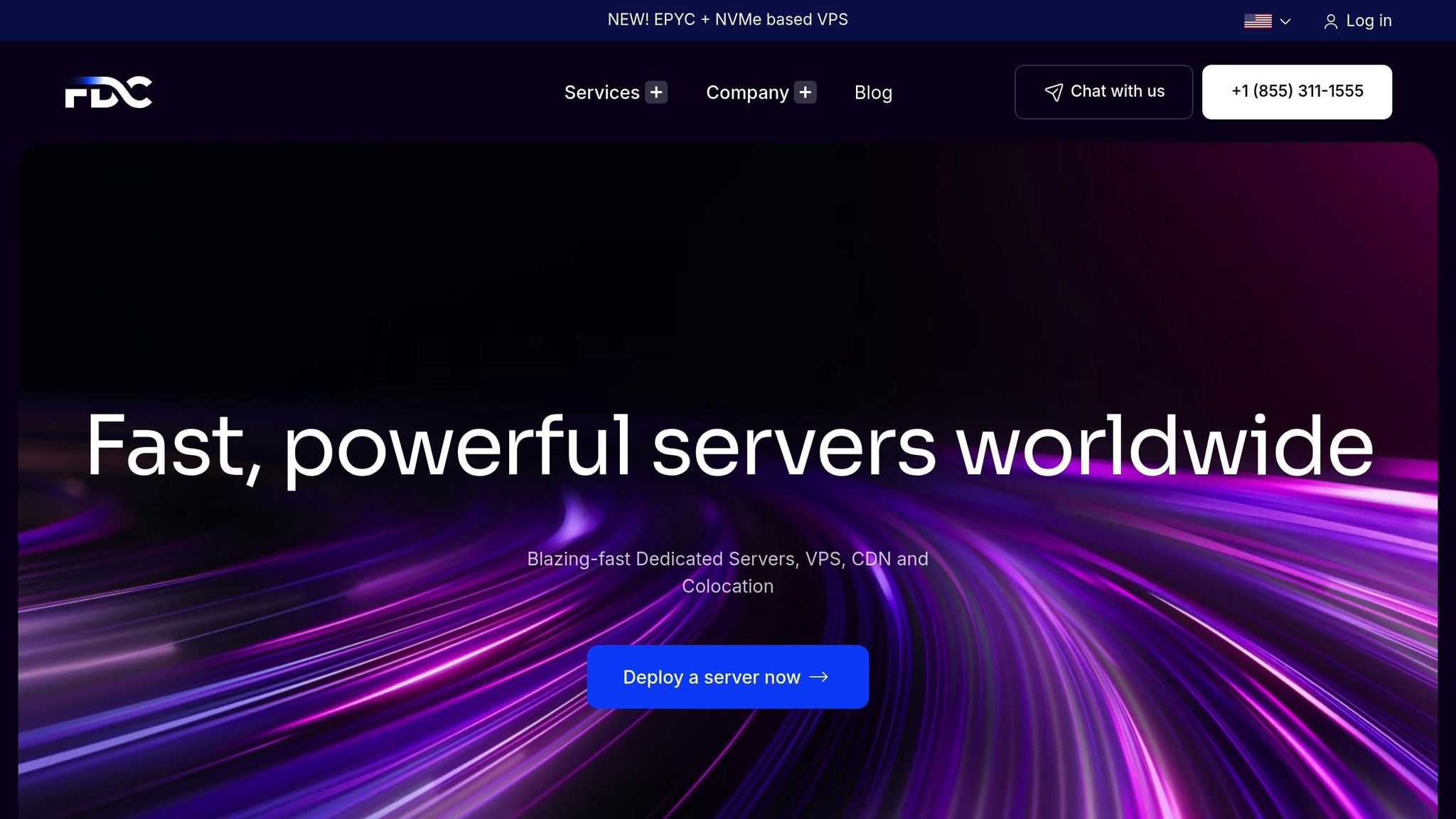NEW! EPYC + NVMe based VPS
12 min read - October 13, 2025

Egress charges can significantly increase cloud hosting costs; understanding and managing these fees is essential for budget control.
Egress charges can quietly inflate your cloud hosting bill. These are fees charged by cloud providers whenever data leaves their network, and they can account for 10–15% of your total cloud costs. Businesses often overlook these charges, leading to unexpected expenses and budget issues.
Key points to know:
To reduce costs, consider strategies like:
Providers like FDC Servers offer solutions like unmetered dedicated servers and flat-rate CDN services to help manage these costs effectively. By planning carefully and leveraging the right tools, you can avoid "bill shock" and keep your hosting expenses under control.
Cloud providers, often referred to as hyperscalers, base their egress charges on where your data is going and the types of services generating the traffic. Your final bill depends on several factors, including the destination of your data and the specific services involved.
Most hyperscalers use tiered pricing models, where rates vary depending on the destination of your data and how much is transferred. Generally, egress fees fall into three main categories:
Some providers offer a limited amount of free outbound data each month, but once you exceed that limit, charges increase based on usage. This tiered structure makes it critical to analyze your traffic patterns to predict costs accurately.
Now let’s look at how different service types can influence these charges.
Egress fees also vary depending on the type of cloud service you’re using:
Understanding how these services contribute to your bill is key to managing expenses effectively.
Where your data is sent plays a major role in determining your egress costs. Transferring large volumes of data or sending data from regions with higher operating costs can quickly drive up expenses. For organizations with significant data transfer needs, careful planning is essential to avoid unnecessary charges.
Some providers offer lower rates during off-peak times. However, in many cases, the cost is determined by the source of the data rather than the destination. For instance, data leaving a region with higher rates will carry those costs, no matter where it’s headed.
Unexpected traffic spikes - caused by events like viral content or sudden surges in usage - can further complicate your cost management efforts. To avoid surprises on your bill, it’s crucial to monitor your data flows closely and manage them proactively.
Egress charges can quietly transform what seems like an affordable hosting solution into an unexpectedly expensive one. Many businesses only realize the impact of these fees when they get their first invoice, and by then, the costs have already added up. This unpredictability can turn straightforward budgeting into a financial headache.
Certain industries are especially vulnerable to surprising egress fees:
The impact of egress fees becomes even more apparent for businesses with global operations. For example, a growing SaaS company with users worldwide might see outbound traffic from API responses, file downloads, and real-time synchronization eating up a large chunk of its budget. As the user base grows, these charges can escalate quickly, creating new financial pressures.
Similarly, platforms dealing with heavy content, such as digital asset management tools, often face higher egress fees due to frequent downloads and file previews. When combined with other costs like storage and computing, the total monthly bill can rise sharply.
Unpredictable traffic patterns can make managing egress costs even more challenging:
Unlike fixed costs such as storage or server instances, egress fees are highly variable. They depend on factors like user behavior, content popularity, and external events. This unpredictability forces businesses to either overestimate their budgets to cover worst-case scenarios or risk being caught off guard by unexpected expenses. Such challenges highlight the need for strategies to control and reduce these costs effectively.
Cutting down on egress fees takes careful planning to find the right balance between saving money and maintaining strong performance. Luckily, there are several effective ways to reduce these costs without affecting the quality of your service. Here’s how you can manage egress expenses more efficiently.
Content delivery networks (CDNs) are a practical solution for lowering egress fees. By caching content at edge locations closer to your users, CDNs minimize the amount of data pulled from your origin servers. This setup is especially helpful for applications that rely heavily on static content like images, videos, CSS files, and JavaScript.
CDNs not only reduce long-distance transfer costs but also improve user experience by lowering latency. For example, FDC Servers offers a CDN service priced at $4.00 per TB ($0.004 per GB), providing a cost-effective way to deliver content predictably and efficiently.
Private interconnects and direct peering arrangements are another smart way to reduce egress costs. These connections bypass the public internet, replacing variable per-GB charges with flat monthly fees. For businesses with consistent, high-volume data transfers, this approach offers both cost predictability and improved performance.
Direct peering is particularly useful for tasks like regular data synchronization, backups, or multi-cloud setups. By transferring large datasets over dedicated connections, businesses can avoid high egress fees while benefiting from reduced latency and greater reliability. For hybrid environments, private interconnects also streamline data flow between cloud and on-premises systems, keeping costs under control.
When paired with hybrid strategies, private connections can further shield businesses from fluctuating egress expenses.
Hybrid infrastructure strategies distribute workloads across different environments to reduce dependence on costly hyperscaler egress fees. This involves using dedicated servers and colocation for high-bandwidth tasks while relying on cloud resources for variable workloads.
Unmetered dedicated servers and colocation services eliminate egress fees for bandwidth-heavy operations. Meanwhile, cloud resources handle traffic spikes and unpredictable workloads. For example, hosting static assets and high-bandwidth services on dedicated infrastructure ensures that most traffic is served without incurring egress charges. Cloud platforms can then be reserved for handling dynamic workloads.
Additionally, IP transit services complement hybrid setups by offering scalable, high-capacity connectivity options. With bandwidth options like 10, 100, and 400 Gbps, businesses can scale as needed without the unpredictability of traditional cloud egress pricing.
To make the most of a hybrid strategy, businesses need to analyze their workloads closely. Pinpointing which applications generate the most egress traffic and understanding their performance needs helps determine what to host on dedicated infrastructure versus the cloud. FDC Servers' solutions demonstrate how this approach can effectively balance cost and performance, ensuring businesses achieve both efficiency and reliability.

FDC Servers brings practical solutions to the table for managing and reducing egress fees, offering businesses a way to cut costs without sacrificing performance. With transparent pricing and tailored services, they eliminate the unpredictability of data transfer expenses.
FDC Servers’ unmetered dedicated servers make egress fees a thing of the past by providing unlimited bandwidth at no extra charge. Starting at just $129 per month, these servers allow businesses to transfer as much data as they need without worrying about surprise costs. This setup is perfect for companies handling high data volumes, such as streaming platforms or applications delivering large files. Whether your monthly data transfer is 1 TB or 100 TB, the pricing stays consistent, ensuring predictable hosting expenses.
FDC Servers also offers a global CDN service priced at $4.00 per TB per month, giving businesses a straightforward way to manage data transfer costs. This flat-rate pricing includes access to 27 global locations, free automated SSL certificates for custom domains, and a layered DNS system that optimizes latency by selecting the fastest edge for content delivery. By leveraging their expertise in high-bandwidth services and bulk bandwidth purchasing, FDC Servers ensures a simple, no-hidden-fee pricing model that appeals to businesses looking for clarity and affordability.
For businesses pursuing hybrid infrastructure strategies, FDC Servers offers colocation services that eliminate egress fees for customer-owned equipment. These services provide secure, high-bandwidth hosting environments with support for up to 22 kW per rack across multiple global locations. Additionally, their IP transit services deliver flexible connectivity options, offering 10, 100, and 400 Gbps bandwidth tiers with premium connections from leading carriers. This setup enables businesses to create hybrid architectures that host static content, databases, and high-bandwidth applications on colocation infrastructure while using cloud resources for dynamic workloads. The result? A significant reduction in egress costs.
Keeping egress charges in check is key to managing hosting budgets effectively. These data transfer fees often make up 10% to 15% of a cloud bill, becoming a major consideration when selecting hosting solutions. The challenge lies in the complex and variable pricing models, which can turn an initially affordable hosting plan into an unexpectedly costly expense.
To manage these costs, start by auditing your traffic patterns, estimating potential egress needs, and using tools like CDNs or private connections. These strategies not only help control spending but also ensure your hosting remains efficient and reliable. That said, the unpredictable pricing structures of traditional hyperscalers often make it difficult for businesses to maintain stability.
A better solution? Opt for a fixed, transparent pricing model. Fixed-cost, unmetered bandwidth makes it easier to budget and removes the worry of rising egress fees as your business grows. This approach is especially beneficial for high-traffic applications, streaming platforms, or businesses that experience fluctuating traffic demands.
By combining unmetered dedicated servers, cost-effective CDN services, and flexible colocation options, you can create an infrastructure where egress costs are not just predictable but manageable. This clarity allows you to concentrate on scaling your business and delivering value to your customers.
Whether through hybrid setups, private connections, or providers that eliminate egress fees altogether, the goal is clear: reliable, high-performance hosting that aligns with your business objectives - without straining your budget.
To keep egress charges under control during times of fluctuating traffic, businesses should rely on real-time monitoring tools. These tools allow companies to track data transfer volumes and related costs as they happen. By spotting patterns and catching sudden surges quickly, businesses can make adjustments before costs spiral out of control.
Another effective approach is leveraging Content Delivery Networks (CDNs), private interconnects, or hybrid infrastructure solutions. These strategies help reduce the amount of data moving across regions, which can lead to noticeable savings on egress fees. By keeping traffic local and streamlining data flow, businesses can manage their expenses without sacrificing performance.
Businesses can cut down on egress fees by leveraging content delivery networks (CDNs). CDNs store and deliver content from locations closer to users, which reduces the distance data needs to travel and, in turn, lowers transfer costs. Another smart move is compressing data before transferring it - this reduces the volume of data being moved without impacting performance.
Optimizing data routing is another key tactic. By keeping traffic within the same cloud region or provider whenever possible, businesses can sidestep pricey inter-region transfers and ensure smoother data flow. Additionally, using private interconnects or hybrid infrastructure solutions can help manage costs while maintaining reliable performance.
Industries like media streaming and e-commerce face steep egress costs due to the massive amounts of data they transfer to users. These outbound data charges from cloud providers can pile up quickly, putting a strain on budgets.
To tackle these costs, businesses can take several practical steps. One popular solution is using Content Delivery Networks (CDNs), which store content closer to users, cutting down on the data pulled directly from the cloud. Another approach is regional data processing, which reduces the need for cross-region data transfers. Additionally, private interconnects and hybrid infrastructure solutions offer a way to lower data transfer expenses while ensuring performance stays on track. By adopting these strategies, companies can keep their hosting costs in check without compromising the quality of their services.

Explore the best monitoring tools for dedicated servers and VPS in 2025, focusing on AI, automation, and real-time analytics.
12 min read - November 28, 2025

Flexible options
Global reach
Instant deployment
Flexible options
Global reach
Instant deployment